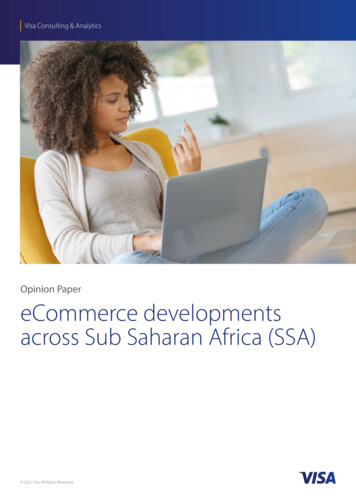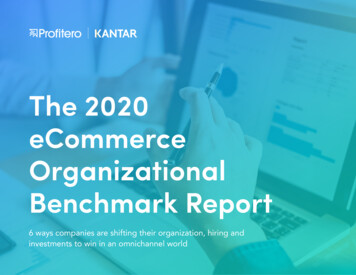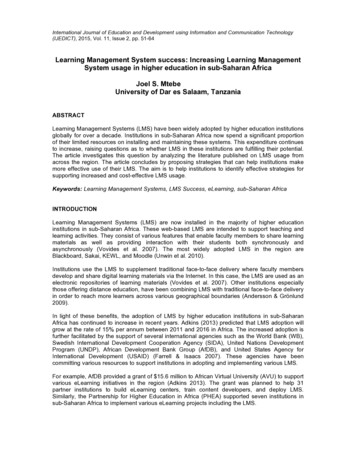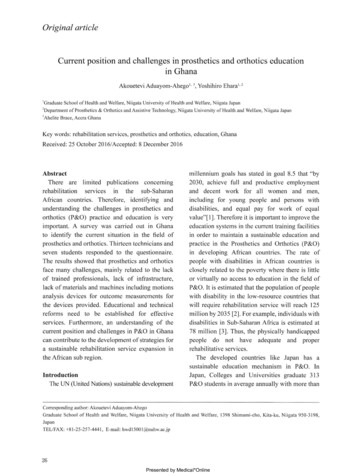
Transcription
Visa Consulting & AnalyticsOpinion PapereCommerce developmentsacross Sub Saharan Africa (SSA) 2021 Visa. All Rights Reserved.
Executive SummaryAs the world becomes increasingly digital, eCommerce has been driving commerceinto the digital age.eCommerce has experienced phenomenal growth rates around the world and even recent setbacks as aresult of the continuing COVID-19 pandemic haven’t stopped its rise. In fact, eCommerce sales are projectedto grow to 7 trillion across the globe by 2024.1What role does Sub-Saharan Africa (SSA) have to play?Sub-Saharan Africa may be one of the smallest regions of ecommerce globally, but SSA shows steady growthpotential. The leading markets in SSA – South Africa, Nigeria and Kenya – are starting to mature, providing theregion with an established foundation and when twinned with the growing penetration of eCommerce itoffers payment issuers and acquirers an opportunity they can capitalize on while helping to further acceleratethe expansion of eCommerce in the region.Key eCommerce drivers in the region: On average cross-border dominates:However, in two of the top markets on thecontinent (South Africa and Nigeria) domesticplayers dominate, showing a maturing base ofregional eCommerce merchants. eCommerce in SSA is driven by retail goodsand professional services: Investment,accounting, business-to-business and billpayment services are important eCommercemerchant categories. Mobile phones are the main source of digitalaccess in SSA: this drives the ease andconvenience of mCommerce as a primary accesspoint in SSA. Card usage is still a key enabler ofeCommerce: Interestingly, prepaid cards have astrong role to play in this space by providingconsumers an easy way to control funds availablefor eCommerce. Payment facilitators are a critical catalyst fordigital payments: In the last 5 years paymentfacilitators have become a key player in theeCommerce value chain. Fraud protection is key to maintainingcustomer trust: Many customers in SSAare making the jump from physical to digitalpayments so it is important to not only havestrong controls but educate and communicatewith customers, so that they feel safe usingtheir cards. Regulation is an enabler and foundation forinnovation: SSA has a history of creatingregulation that not only maintains supportivepayment systems for eCommerce but enablespayments innovation, particularly inmobile money. The COVID-19 pandemic has drivencustomers to eCommerce and digitalpayment usage: the economic shocks thatfollowed COVID-19 have reduced spendingpower across the world, including SSA, but theclosure of physical stores has provided a growthopportunity for digital payments andeCommerce itself.1. Source: The Wall Street Journal: E-Commerce to Total a Quarter of Global Retail by 2024, GroupM Forecasts, Decemeber 20202Visa Consulting & Analytics
These drivers mean that issuers, acquirers and merchants in SSA need to consider: Designing eCommerce for mobile:This means ensuring that customers haveseamless access through mobile channels,particularly when it comes to making digitalpayments on mobile devices. Ensure a variety of payment channels areavailable: Customers want options, so digitalpayment providers need to respond with multito omni-channel options. Payment facilitators area good potential partner in this space. Make cross-border transactions seamless:eCommerce in the region is being driven bycross-border transactions. To make the most ofthis revenue opportunity these transactions needto be enabled from the point of issuance to thepoint of acquiring. Cater for local: While global cross-bordermerchants play a key role, local SSA merchantsare rising up. There is an opportunity to supportthese players by not only providing digitalpayments support, but broader merchant valueadded service offerings. Keep the customer at the center of productdesign: Digital enables providers to personalizetheir products at scale, making the most of thisopportunity means that providers can create thebest customer experience for the emergingdigital savvy SSA eCommerce customer. Go virtual: Prepaid cards have a strongeCommerce value proposition, but thisopportunity can be taken one step further– by going virtual.Visa Consulting & Analytics Provide payments infrastructure adapted forgoods and services provision: eCommerce inSSA isn’t restricted to retail, so the paymentsinfrastructure shouldn’t be either, it needs to lookat the wider scope of platform and individualmerchant enablement for services provision. Ensure strong fraud protection controls aren’timpeding growth: Fraud controls are essentialto protect all parties involved in eCommerce –customers should be educated about them sothey feel safe spending – but these controlsshouldn’t stop customers from completingtrustworthy eCommerce transactions.3
eCommerce in the world todayFor the last 10 years eCommerce has been steadily growing across the globe, and it isn’texpected to stop any time soon.Increased internet usage and mobile penetration twinned with a rapid growth in eCommerce merchants whooffer convenience, accessibility, competitive pricing and personalized offerings has contributed to the shift inconsumer preferences towards digital commerce over the past decade.In fact, eCommerce sales are projected to grow to 7 trillion across the globe by 20241: Asia Pacific (APAC), specifically, China, India, andSoutheast Asia are a key driving force behind theeCommerce market and represent 56% ofworldwide volume.Countries in the Middle East and North Africa(MENA) region have the largest growth potentialover the next 5 years with a Compound AnnualGrowth Rate (CAGR) of 23% (almost twice that ofother regions)2.SSA lags behind MENA, but still shows strongpotential having seen a 42% year-on-year growthacross the region from 2019-20203.This has been driven, in part, by the ongoingCOVID-19 pandemic, with the implementation oflockdown restrictions across the world to curb thespread of disease, face-to-face retail was shut downand customers had to turn to eCommerce to fill thevoid its closure left behind. In SSA alone thelockdown saw new eCommerce users rise by 5%when compared to the active base in SSA theprevious year.However, it is important to note that thepandemic hasn’t impacted eCommerce productcategories equally in SSA: Quick Service Restaurants and traditionalofferings that converted to a takeaway foodmodel saw a rise of over 160% in usageduring lockdown. Retail services, groceries, pharmaceuticals andbuilding supplies all saw increased usage ofaround 50%. While unfortunately, travel, fuel, luxury retaildepartment stores, and apparel saw expendituredecline due to economic challenges andmovement restrictions.Despite the pandemic driving more consumersonline there was still a slight deceleration in globaleCommerce sales in 2020. This can be attributed tothe global economic shocks the pandemic broughtwith it, so, while spend was driven online, spendingpowder has been reduced. But, this isn’t bad news,eCommerce is expected to pick up again in 2021,and the overall drop in the growth rate ofeCommerce transaction volumes in 2020 was offsetsomewhat by the growth of smaller transactions inareas such as contactless and remote payments fordigital and physical goods. eCommerce decline ispredicted to reverse in over 2021 and 2022, and aseCommerce returns to a growth period it willexperience lasting benefits from the pandemic –keeping the new users and the slew of merchantsthat turned to the online environment while theywere stuck indoors.1. Source: The Wall Street Journal: E-Commerce to Total a Quarter of Global Retail by 2024, GroupM Forecasts, Decemeber 20202. Source: Business Insider Intelligence: The Payments Forecast Book (2019)3. Source: Statistica, Ecommerce: Africa, 20204Visa Consulting & Analytics
Sub-Saharan Africa’s OutlookSSA may currently be one of the globe’s smallest eCommerce regions, but it showsstrong growth potential.South Africa, Nigeria and Kenya are driving theCP, CNP and eCommerce volumes in SSA:If we look at eCommerce in the context of SSA’scard market, we see that eCommerce provides alever in driving customers towards embracingCard Not Present (CNP) transactions: However, CNP transactions are growing andslowly gaining ground. CNP growth is largely driven by eCommercewhich made up the majority of all CNPtransactions in 2020. South Africa sits in first place of total volumesin 2019 and 2020, while Nigeria sits in secondplace, followed by Kenya and Ghana ranked injoint third. They are followed by Mauritius in fouth,and Zambia in fifth, showing the relevanceof eCommerce spreading across East,South and West Africa (refer to Figure 1 formore information). However, when South Africa’s dominanceis excluded from the analysis, Nigeria and Kenyamove up the SSA eCommerce rankings.Figure 1: Top SSA eCommerce Countries (2019-2020)Ghana32Nigeria3ZambiaKenya54South AfricaMauritius1Source: VisaNet, Sep ’19 – Sep ‘20Visa Consulting & Analytics5
Box 1. Overview - Key Contributors to eCommerce in SSAThe top contributors to eCommerce inthe region over the last 3 years, in order ofcontribution, were South Africa, Nigeria andKenya. South Africa is by far the dominantplayer at the moment and Ghana is showinggrowing relevance having replaced Kenya inthe top three contributors in 2020.If we take a deeper look at merchantcategories driving eCommerce, we can seethat despite professional services (such aslegal and accounting) staking its place as a keymerchant category across all three countries,as the top merchant category for Kenya andSouth Africa, and second place in Nigeria.6Visa Consulting & AnalyticsThe importance of goods-based merchantsversus service-based merchants still varies: While Kenya and Nigeria show a continuingdedication to service-based merchantswith a strong spread across servicescategories such as professional services,education, government and business-tobusiness merchants. In Nigeria, a good portion of PV is driven bygoods purchases from discount stores. Thisdominance has been boosted by the rise oflocal eCommerce merchants, such as Jumia,that fall into this category. While in South Africa, professional servicesand telecom/utilities merchants were thetop drivers of eCommerce in 2020. However,goods remained important.
Box 1. Overview - Key Contributors to eCommerce in SSAKenyaNigeriaKey merchant categoryrankings:South AfricaKey merchant categoryrankings:Key merchant es1ProfessionalServices1Education& Business ToBusiness2Business ToBusiness3DiscountStores3Airlines3Education Services4Source: VisaNet, Jan ‘18 – Sep ’20; Sep ’19 – Sep ‘20Visa Consulting & Analytics7
What is driving eCommerce in the region?Cross-border dominatesCross-border transactions make up over half of all eCommerce transaction volumes in SSA, this mirrors theglobal trend of online business to consumer (B2C) online shopper cross-border transactions4. However, aportion of these cross-border volumes in SSA come from consumers accessing the rising domestic AfricaneCommerce stars across local borders, such as Jumia (Nigeria), Kilimall (Kenya) and Takealot (South Africa). Asdomestic eCommerce provision in SSA is only just beginning it presents an exciting opportunity for SSA todevelop its own big hitters in the eCommerce market and increase the continents’ connection to the rest ofthe world.4. Source: yStats.com Global Cross-Border B2C Ecommerce (2020)8Visa Consulting & Analytics
eCommerce is driven by goods and services in SSAWhen examining the top eCommerce merchant categories across SSA, one key trend is that all of thecategories focus on the provision of goods and services. No matter whether you look at the top merchantcategories by volume or transactions (as shown by Table 1) even though the rankings change, the same fivemerchant categories appear. This information is particularly important to acquiring models that are driven byfee per transaction.Table 1. Top SSA eCommerce Merchant Categories (2019-2020)Top Merchant Categories By VolumeTop Merchant Categories By Transactions1. Professional Services1. Discount Stores2. Discount Stores2. Retail Goods3. Business To Business3. Transportation4. Telecom/Utilities4. Business To Business5. Education & Government5. Telecom/Utilities6. Retail Goods6. Professional ServicesSource: VisaNet, Sep ’19 – Sep ‘20Visa Consulting & Analytics9
Mobile phones are the main access point to all things digitalAcross SSA access to the online world is largely facilitated by mobile phones (see Box 2 for more detail). Whileinternet penetration is growing, it is often limited to urban areas and even when there is strong internetaccess, mobile devices are often preferred. At times mobile data access is even used to provide online accessvia hotspotting for other devices such as laptops. This trend isn’t confined to SSA, in fact mobile commerce(mCommerce) accounted for two thirds of global eCommerce spend in 20195. Furthermore, mobile devicesdon’t just provide access to eCommerce, they can themselves be a payment instrument. As a resulteCommerce acquirers need to ensure that their eCommerce platforms aren’t just online friendly, but are alsomobile friendly for everything from browsing through to payments.Box 2. Overview - eCommerce EnablersThe most important eCommerce enablers are;the ability to access financial services, digitalpayment channels and digital infrastructure,these enablers are starting to take hold acrossSSA. Cash may remain the dominant paymentinstrument in the region for now, but we areseeing signs that this will eventually change: Although bank accounts drive financialaccess in Nigeria and South Africa, in Kenyafinancial access is largely driven byMobile Money. Cash is particularly prevalent in Nigeria, butKenya and South Africa match their topdrivers of access with their second highestpayment instrument usage – electronicpayment instruments (likely mobile money)in Kenya and cards in South Africa. Digital access is primarily enabled by mobilephones across all three markets. Internetpenetration is highest in South Africa atjust under two thirds of the population,while Kenya and Nigeria each have just overone third of population with digital accessthrough the internet.5. Source: eMarketer Global Ecommerce June 202010Visa Consulting & Analytics
Box 2. ContinuedKenyaNigeriaFinancial InclusionBanked Population:82% of popl.Traditional Banked:56% of popl.Mobile Money Account:Banked Population:Banked Population:40% of popl.70%Traditional Banked:Traditional Banked:40% of popl.Mobile Money Account:6% of popl.68%of popl.of popl.Mobile Money Account:19%of popl.Spend Overview73% of popl.South AfricaDigital ReadinessCashChequeElectronic Direct/ACHOther Payment TypesCardInternet Penetration:Internet Penetration:Internet Penetration:42% of popl.62% of popl.Mobile Phone Connection:Mobile Phone Connection:Mobile Phone Connection:43% of popl.98% of popl.83% of popl.176% of popl.Source: World Bank, Global Findex Database 2018; Hootsuite, Digital 2020: Kenya/ Nigeria/ South Africa, 2020; Euromonitor, Merchant Segment Study (MSS)2019-20, June 2020Note: Banked Population %, Traditional Banked % and Mobile Money Account % based onpopulation 15 Visa Consulting & Analytics11
Card usage remains a key enabler and prepaidcards are a rising starFraud protection is key to maintainingcustomer trustCard usage for digital payments in eCommerce isobserved across all card types: debit, credit andprepaid. Credit and debit show almost equal usagefor eCommerce transactions of volume respectively,and card preference appears to be strongly driven bygeneral market preferences.Customers need to know that they are not openingthemselves up to risk when they make digitalpayments on an eCommerce platform. Whether thisrisk is perceived to be a lot higher than it is or not,fraud in SSA was less than 1% of CNP transactionsover the last year, but half of those transactionswere linked to eCommerce. This shows customersthat the correct fraud and cyber-crime preventionprocesses are in place is the key to getting themto embrace eCommerce.For instance, in South Africa credit is favored, whereasin Nigeria the use of debit remains top for domestictransactions and credit for cross-border.Despite having a smaller transaction volume,prepaid cards have a unique eCommerce use caseacross the continent – prepaid offers consumers theopportunity to ensure fraud protection by not linkingback to a bank account and enable tight spendingcontrols as only the funds the customer has loadedto the card can be spent.Payment facilitators are a critical catalyst fordigital paymentsIn the last 5 years payment facilitators have becomea key player in the eCommerce value chain byenabling access to digital payments through theplatforms they have created, such as, PesaPal, DirectPay Online (DPO) and Paystack. As a baseline theseproviders have become the eCommerce acquiringfacility for merchants, but they also enable customersto access a range of payment options allowing themto pick the one that works best for them.12Visa Consulting & AnalyticsHowever, it is important that these fraud controlsdon’t cause unnecessary declines and customerfrustration. The rate of declines or failed transactionsfor other reasons in SSA is just under 30%, andcross-border payments regularly find themselves inthis category. It is critical for payment providers toreduce these decline rates, ideally to just below 10%,by making use of controls that prevent fraud andcutting-edge risk modelling practices to ensure thatany declines are actually preventing fraudulentactivity and not frustrating a legitimate buyer.
Regulation as an enabler and foundation forinnovationRegulators have to balance their mission of ensuringa sound and efficient payments system withsupporting innovation, a balance which becomeseven more important as payments shift towardsthe digital. In SSA the shift to digital has beenparticularly dynamic: A whole new class of players have emerged inthe world of mobile money. Payment facilitators and processors have becomekey players to enable eCommerce payments andmove merchants online. Beyond this, evolutions are taking place inpayment products, channels, infrastructure andeven the state of money itself towards digital fiatcurrency6.SSA regulators have not only been able to keep pacewith these innovations and ensured they areregulated to protect consumers by providing safeenvironments to transact in. They have alsoencouraged innovation through the creation ofregulatory sandboxes (in Kenya, Sierra Leone,Mauritius, Mozambique, Uganda and Nigeria)8 andfintech/tech committees and units (such as theSouth African Reserve Bank Fintech Unit)8.COVID-19 may have disrupted spend but ithas also driven customers to eCommerce anddigital paymentsThe pandemic has provided a positive discoveryopportunity for both digital payments (an enabler ofeCommerce) and eCommerce itself. While spendingpower has reduced over the continent as a result ofnumerous lockdowns, spending on eCommercehasn’t reduced to the same extent as face-to-facespend, in fact the closure of face-to-faceenvironments has attracted new users and increasedthe frequency of spend in the eCommerce space.COVID-19 has given eCommerce the opportunity togrow and potentially cement its new growth. Tomake the most of this, eCommerce players need tobe thinking about how they can provide consumerswith a continuing positive experience enabled bysafe and seamless digital payments (that enablethem to keep their distance, see Box 3 for moreinformation) so that their new consumers have theconfidence to keep spending online after they nolonger have to.6. Source: KPMG, 10 predictions for the future of payments, 20197. Source: FSD Africa, FinTech and Regulation: Thinking outside the (sand)box, 20208. Source: RMB, South African Regulators Leading The Charge In Disruptive Innovation, 2019Visa Consulting & Analytics13
Box 3. COVID-19 as a Digital Payments DriverThe Covid-19 pandemic has pushed consumers towards digital payments in the key eCommercemarkets for SSA.At a primary level of cash versus digital payment instruments, there has been a strong move awayfrom the use of cash across the board. This is due to a shift to eCommerce behavior that is mostlyenabled by digital payments (with the exception of cash on delivery) and a reduced preference forface-to-face interactions that involve handling common surfaces which could be a vector for the virus,such as cash.When exploring the digital payments usage, the use of cards has increased across the continent, withthe highest uptick taking place in Kenya. However, the nature of this usage is also interesting. Therehas been a strong preference for contactless, a notable point for enabling safe card payments ondelivery, as well as in the use of e-wallet services (often enabled by card-on-file). Mobile paymentswere also a key channel, particularly in Kenya which is dominated by Mobile Money.KenyaSouth AfricaNigeriaW1W2W3W1W2W3W1W2W3Cash / Cash on Delivery-34-17-27-14-7-3-56-54-55Credit cards (chip & pin)112830161829545149Debit cards (chip & pin)344240495454565950Prepaid cards163012173133395233Contactless cards516250415150666058Mobile Payments364538506149889484e-Wallet e: Consumers using respective payment methods* Net Effect is calculated by subtracting the % of respondents stating increasefrom the % of respondents stating Decrease for each payment method-31and less-21 and -30-1 to -200 to 20All figures are in %Decrease vs. Wave 2Increase vs. Wave 2 21 to 20Wave 1Wave 2Wave 317 May - 22 May 20203 June - 9 June 202023 June - 29 June 2020 41 to 60 60 and aboveSource: Visa, COVID 19 Impact Tracker in CEMEA, 2020Note: The question asked was: Q5 What has been the impact of Covid-19 (Coronavirus) on the different payments methods that you generally use for yourpurchases? Would you say that it has increased, remained the same or decreased?14Visa Consulting & Analytics
What next?How can issuers, acquirers and merchants capitalize on these opportunities?Mobile, mobile, mobileMobile phones are a key access point for eCommercein SSA, not only are they a source of mobile dataallowing transactions on other devices but they arealso a payment mechanism in mobile money– this makes it critical that eCommerce platformsare designed with end-to-end mobile enablementin mind.For payments, both online and for any payment ondelivery methods, this means that: Online payments need to provide a strong UXexperience that appears seamless to thecustomer no matter the often low or intermittentinternet connectivity.While face-to-face digital payments on deliveryshould leverage the ever developingtechnologies of POS on mobile to ensure agreater chance of connectivity wherever thedelivery takes place through a lightweightdevice. For example, making use of SoftPOSor mPOS.Visa Consulting & AnalyticsEnsure a variety of payment channelsare availablePayment facilitators have become a key enabler inthe eCommerce value chain by providing access todigital payments acquiring. This follows a globaltrend and across the world generating the questionof partner, buy or compete to any other acquirerslooking to engage in this space.Customers in SSA are making use of a wide range ofdigital payment instruments, so it is becomingincreasingly important that eCommerce offers multiand even omni-channel experiences.They need to provide customers with choices thatspan not only payment instruments, such as cardsand mobile money, but multiple channels such asonline gateways or SoftPOS/mPOS on delivery.Offering this choice allows customers to transact inthe way that is most convenient and comfortable tothem – ultimately reducing churn or drop offs foreCommerce merchants.15
Make cross-border transactions seamlessCross-border transactions dominate the SSAeCommerce landscape. It is important to thinkthrough how to make these transactions as easy aspossible. Key aspects to consider include: Enabling multi-currency options that removethe risk of currency fluctuations from theequation and increase the ease of transactingacross borders. Ensuring access to payment instruments thatenable safe cross-border payments for customersthrough their preferred instruments, whether itbe card, mobile money or other. Increasing partnerships with global merchantsthat make transacting and payment easy for SSAcustomers. The growing customer base in SSAwhich is so strongly cross-border focused shouldbe a target focus for key global merchants.Payment providers can facilitate this focus andenabling easy transacting with these playersthrough partnerships that seamlessly enablepayments through SSA channels.Cater for localWhile global cross-border merchants play a key role,there are strong regional and local players rising upacross the region. There is an opportunity to supportthese players not only by providing digital paymentssupport, but through broader merchant value addedservice offerings such as white label online storeinfrastructure, inventory tracking or businessservices support.16Visa Consulting & Analytics
Keep the customer at the centerGo virtualThe rise of digital has increased customers’expectation of a personalized experience and bringswith it the opportunity to get to know customers atscale. For acquirers and issuers, this can mean boththe merchant and the ultimate end customer.A greater understanding of customer needs enablesproviders to design targeted solutions that result inmuch higher satisfaction. This includes both productand servicing design. It is important to not only focuson the right Customer Value Proposition (CVP) butensure that the full customer experience surroundingthis proposition executes on the value it promises- customer-centric design requires fullend-to-end focus.Current usage demonstrates that there is a stronguse case for prepaid in the eCommerce world, andthe freedom to introduce spend controls will keep ita key use case for the future. However, the prepaidworld is evolving to include virtual cards, and thebenefits these provide due to their easy activationand usage (including the ability to spin up multiplecards, each with a designated usage) mean they canbe leveraged to enable easy digital eCommercepayments in SSA.Provide a payments infrastructure adapted forgoods and services provisionThe top merchant categories in SSA don’t just focuson retail goods, they include a wider range of goodsand services. This means the eCommerce paymentsinfrastructure can’t just be built for retail, they needto look at the wider scope of the platform andindividual merchant enablement forservices provision.Ensure strong fraud protection controlsConsumers can be put off using eCommercebecause they are afraid that it makes the morevulnerable to fraud. This makes it important to ensurethat fraud controls are in place which protect bothissuers and consumers, while not becoming animpediment to completing trustworthy eCommercetransactions. Once they are in place it is importantto educate consumers about these protections sothat they are not afraid to operate in theeCommerce environment.Visa Consulting & Analytics17
Box 4. Key Market OpportunitiesSouth Africa shows potential for investmentAt the moment South Africa is the dominantmarket in SSA. This dominance is driven bythe prevalence of domestic over cross-bordertransactions. There is potential to leveragethe mature infrastructure of this SSA market(including well developed payments system)to launch eCommerce across the region whilebringing further cross-border options intoSouth Africa.Within South Africa, while it is the dominantmarket there is still a strong opportunity toshift more face-to-face commerce activity todigital payments in eCommerce.Kenya and Nigeria are rapidly growingmarkets with growing local playersIn Kenya eCommerce transactions are mainlydriven by cross-border merchants. This meanstwo things, firstly there is potential for the localeCommerce market to develop, and secondlythat we need to examine if sufficient acquiringinfrastructure exists domestically to enablethese players.The growth of eCommerce is currently drivenby both digital payments and cash-on-deliveryin Kenya, showing the potential to convertmore customers to digital payments throughCNP (such as card-on-file) and CP (SoftPOS ormPOS) activities.18Visa Consulting & AnalyticsIn Nigeria there is a greater dominance ofdomestic transactions driven by purchasesfrom Discount Stores, as well as various servicescategories.The growth of strong eCommerce merchantswithin local countries are starting to mature andshow pan-regional penetration (for exampleJumia in Nigeria). This means there is strongpotential for payments providers to partnerwith growing pan-regional players to supportthis growth.
Visa Consulting and Analytics can help you get to gripswith eCommerce.VCA are perfectly positioned to help you understand eCommerce and formulate actionable strategies toimprove your eCommerce customer value propositions, product designs and execution so that you aremaking the most of the eCommerce opportunities available to you in SSA.High-level ApproachKeyAreasStrategyAssessment Benchmark vs. localcompetitors andglobal competitors Assessment ofinternal culture andorganization Assessment ofcustomers digitalengagement Assessment ofdigitaland / oreCommerce spendperformance (i.e.eCommerce,contactless, Paysadoption, etc.) Definition of digitalperimetre & ambition Development of fullyfledged strategy Prioritization of digitalinitiatives Identification of keyenablers (inc.governance)Key Initiatives Identification anddesign of revenuesincreasing initiatives Identification anddesign of costoptimization orproduct developmentinitiatives (i.e. instantissuan
consumer preferences towards digital commerce over the past decade. 1. Source: The Wall Street Journal: E-Commerce to Total a Quarter of Global Retail by 2024, GroupM Forecasts, Decemeber 2020 2. Source: Business Insider Intelligence: The Payments Forecast Book (2019) 3. Source: Statistica, Ecommerce










